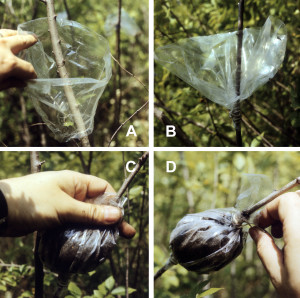By 2015-2016 POP Education and Outreach Intern, Alyssa Schimmel.
In this edition of our Edible Plant Propagation series, we’ll cover cuttings and layering as easy and inexpensive methods for generating new fruiting vines and berry bushes for your garden or orchard.
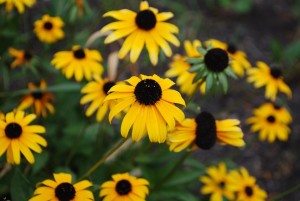
Cuttings and layering are two forms of asexual or vegetative propagation in which we use leaves, stems, or roots from a parent plant to regenerate genetically identical clones. One of the main advantages of this is that it allows us to regrow the strongest plants we may have started from seed and have grown out into full maturity with less time than it would take for us to wait for seedlings from the parent to mature with their varying characteristics.
Often, we’re choosing plants for the strength of certain desirable traits – like beautiful foliage, biggest or sweetest fruit, resistance to disease, early ripening, or attractive flowers. The Bartlett pear and McIntosh apple we’ve come to enjoy are examples of plants that continue to be asexually propagated through cutting and grafting since their selection in 1770 and 1811, respectively. Grafting is the method of joining plant parts so they will grow as one plant – often combining wood from a cultivar with the hardy rootstock of another, as is the practice with many apple, pear, cherry, peach, and plum varietals (and a subject for another post to come). Link here for our article on grafting fruit trees.
While leaf and stem cuttings are frequently used to propagate herbaceous perennial herbs, flowers like pyrethrum and Black-Eyed Susan and some woody species that occupy space in the understory layer of many of POP’s orchards, root, hardwood, and softwood cuttings are the main methods we use to propagate fruiting species.
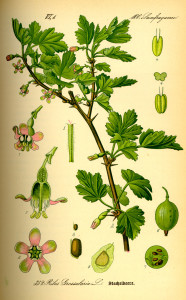
Seasonally, now is the time to focus on root and hardwood cuttings as we ease from the winter cold into the first awakenings of spring. Later in the season as we approach mid-summer, we’ll focus more on softwood cutting where we’ll use the soft, succulent tips or stems of new growth to propagate plants like lavender, lemon balm, lemon verbena, oregano, rosemary, scented geranium, sages, thymes, certain ground covers and vines, as well as many shrubs and trees.
CUTTINGS
Root Cuttings
Root cutting provides a fast method for growing blackberries, raspberries, blueberries, elderberries, currants, and gooseberries. To do so, dig up the whole 2-3 year old plant during the dormant season when the roots have a large carbohydrate supply, or if you’re concerned with disturbing the plant too much, cut down close to the main stems of the plant with a sharp shovel and dig up a segment of the root mass.
If the plant has small roots, take 1-2 inch segments with a knife and pruning shears and lay cuttings horizontally below 1/2 inch of soil medium.
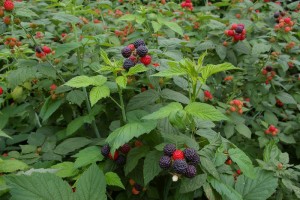
To begin with, you might start with a soilless mix that consists of one part coconut coir or peat moss blended with one part perlite, vermiculite or sterile builders sand. This combination allows proper drainage and aeration for rapid root development. Combine ingredients with a small amount of water until evenly moist. Add a small amount of organic starter fertilizer or seaweed extract to the mix. Replace with a richer potting mix once signs of growth are present.
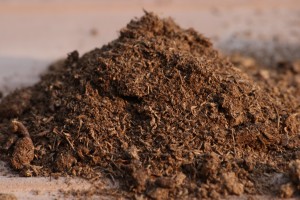
If the plant has large roots, make a straight top cut, and then a slanted cut 2-6 inches below the first. Store for three weeks in moist sawdust, peat moss, or sand at 40 degrees Fahrenheit. Outside, insert the cuttings vertically 4 inches apart with its top level at the surface of the rooting medium in a well prepared bed. Sprouts should appear after a few weeks. Transplant to a permanent location after the sprouts have grown for a least a year in the bed.
Hardwood Cuttings
Hardwood cuttings are the choice method for propagating fruit trees such as figs, pomegranates, mulberries, quince, some varieties of plums, and for fruiting shrubs and vines like currants, gooseberries, grapes, and kiwi fruit. Because cuttings from dormant hardwood lack leaves, it isn’t necessary to provide a high humidity environment to stop the cuttings from drying out before they take root, as with other herbaceous perennials.
When the plant is dormant in the winter or early spring before the buds break, take 6-15 inch hardwood cuttings from the tips of branches with a pencil-width diameter. Cut off any unripened green growth at the tips as you’re wanting to select mature hardwood. It’s recommended to take cuttings from where the current season’s wood, one-year-old wood joins the second year growth at the base of this junction as it has the greatest potential for root development.
At the tip, make a “sloping cut” (diagonal) away from the bud. At the base, make a horizontal cut and, using a knife, exposing some of the cambium – the light green layer you see under the bark when you scrape it away.
At this point, you can dust the exposed base with rooting hormone to increase chances of stimulating root growth, and tap the branch to remove any excess powder. Another method of supplying your cuttings with excess rooting hormone is to water with willow tea or stick willow cuttings in your potting mix to permeate the root zone.
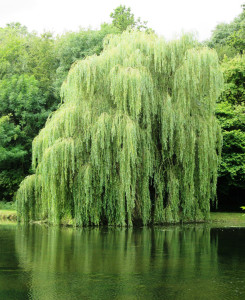
Place cuttings in a container filled with propagating medium (as discussed above), placing as much of the hardwood branch below the surface of the soil – while exposing the top three buds to sit above the soil. Place in a greenhouse or cold frame to speed the process of root development. Cuttings will be ready to plant in the fall. If you choose to plant the cuttings outdoors, mulch them in securely to keep them moist and allow the cuttings to stay in a well prepared bed for a full year – providing them with occasional treatments of liquid fertilizer or manure for several weeks – before transplanting them to their permanent location.
LAYERING
If you’ve been lucky enough to find a plant whose fruit, foliage, or flowers beckon you to beget another, you might choose layering as a method for propagating a new plant from your selected parent. Like cuttings, it’s a type of asexual or vegetative propagation, but where it differs is that you are encouraging development of new or “adventitious” roots on a stem while it is still attached to the parent plant instead of first being removed from it. Once the plant develops new roots, it can then be separated from the parent to grow independently. There are six types of layering: air, simple, tip, trench, serpentine, and mound, which can be read about here, with the most common methods being air-layering and simple, which we’ll explore here.
Air Layering
Developed by the Chinese centuries ago as a way of propagating difficult-to-root plants, air-layering became a method whereby a stem or branch was wounded, dusted with rooting hormone, and packed with sphagnum moss or a similar rooting medium until a new root system developed. Success with air-layering has been documented for many fruiting species including citrus, apples, pears, pecans, hardy kiwis, figs, cashews, and many others. Generally, it’s said that plants that can be propagated through stem cuttings will also most likely root through air-layering. One important thing to keep in mind is that success is largely determinant upon your ability to keep the rooting medium moist so the wounded or girdled section of branch that is to the develop roots does not dry out. Plastic wrap works well to keep the developing roots inside the moss bundle happy.
Fruit trees can be air-layered at any time during the year; but if you choose to start them in spring or summer when the tree is naturally experiencing its most vigorous growth, you could have a new tree ready to plant as early as fall.
To begin, select a pencil-sized shoot and and measure 12-15 inches from the branch tip. Remove the leaves and any twigs on the stem 3-4 inches above and below the layering point so the branch is completely clear of any foliage. Make parallel score cuts on the branch to create a 1-inch ring and remove the bark to expose the bright inner green of the cambium layer. Dust the exposed area with rooting hormone and wrap the exposed site on the branch with damp sphagnum peat moss that has been soaking in water for several hours. Using metal twist ties, secure plastic wrap around the moss bundle on either side like a tootsie roll on either side of the girdled branch.
In as little as a month for some plants, you’ll see roots forming inside the plastic pouch. When they’ve fully formed inside the pouch, remove the plastic keeping the moss surrounding the roots, and using sterilized pruning shears, cut just below the root ball. Your new tree is now ready to be transplanted into a container where it can continue to establish itself or be moved into its permanent location.
Simple Layering
Simple layering is just as easy and works best with shrubs that have flexible branches that can be bent to the ground to root at the site where they make contact. Examples of plants that can be propagated using this method include blueberries, currants, chokeberry, hazelnut, filbert, quince, gooseberry, and saltspray rose. As with any plant to propagate, select healthy plants, free of disease and insect infestation.
Choose a low growing branch about a pencil-width in diameter that has a leaf bunch at its tip. The tip of the branch should extend beyond the level of the soil as this section of the uppermost portion will be needed to photosynthesize energy for the new growth underground. Remove any leaves where the branch makes contact with the ground and wound its underside by using a sterilized knife to create small thin slits.
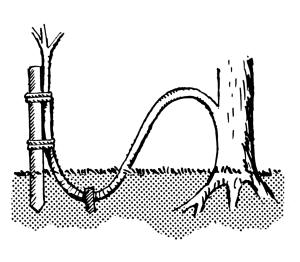
Dig a shallow trench where the branch meets the soil and dust the wounded, exposed branch with rooting hormone. Peat-moss mixed into the trench will help retain soil moisture. Using a stake secure the wounded branch below grow, created a mound above ground. If you’d like, for extra security, you can place a large stone above the portion of the branch below ground. Stake the branch’s tip above ground with a small wood stake to ensure that it grows straight.
Keep the site well-watered. In the early fall, check for root growth; if properly developed, you’ll then be able to transplant the new plant to a well-prepared bed.
With these methods in hand, you’ll be propagating plants in no time!
References
http://www.pbcgov.com/newsroom/0212/02-08-12_air_layering.htm
http://www.ehow.com/how_5519391_air-layer-fruit-trees.html
http://homeguides.sfgate.com/start-young-blueberry-plants-layering-62349.html
http://deepgreenpermaculture.
http://www.planetnatural.com/
The Maryland Master Gardener Handbook
https://www.ag.ndsu.edu/pubs/
http://homeorchard.ucanr.edu/
http://www.geeksongardens.com/
http://pss.uvm.edu/homefruit/
http://www.growables.org/
SUPPORT US! If you found this entry useful, informative, or inspiring, please consider a donation of any size to help POP in planting and supporting community orchards in Philadelphia: phillyorchards.org/donate.
